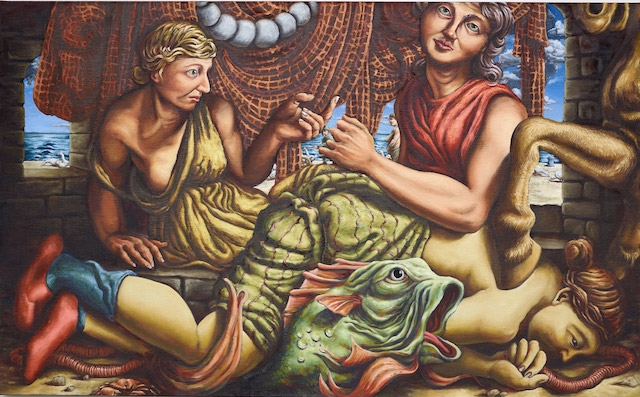A ‘continuous shock’ is an oxymoron, since shocks are defined by their singularity. And yet such a notion, or that of a steady succession of shocks, is appropriate to Jannis Marwitz’s painting. The Brussels-based artist’s earlier trompe l’oeils of stone grave plates from Greco-Roman antiquity, disturbingly painted in bright, contrasting colours, demanded strong reactions. Of late, though, Marwitz has turned to a mashup of styles, from Late Gothic Flemish painting to the Italian Renaissance. His provocation lies in the anachronistic depiction and vulgar genre-hopping, playing with the styles of the Old Masters without copying them. Instead of placing the old on a pedestal, the artist is mischievously reworking it, like wet clay.
In the palm-size, precisely painted Untitled (all works but one 2019), a pensive adolescent, his physiognomy redolent of Flemish Old Master painting, is washed around by waves; a crab pulls his tongue, a sea snake winds around him, a green, witchlike figure pinches his cheek. Water, billowing grey clouds, skin, the fall of the folds – the texture-rich composition is a cluster of painterly porn in the tightest of spaces. Especially enigmatic are two reddish bars, one on the boy’s forehead and the other on his breastbone. Their shape evokes bricks or girders, yet their consistency seems anything but solid. Everything here appears soft, floppy, liquefied, giving the painted world a puzzling instability.
Directly adjacent, and in close correspondence, is the large-format Die Frösche (The Frogs). Against an elegiac background of clouds and hills we again find a young man, maybe the same one, menaced by two geese and an enormous beaky bird, which, again, pulls his tongue. In comparison to the landscape, the figure of the youth appears gigantic, or far above it; in relation to the birds, he seems dwarfish. The composition gives the impression of an allegory, its meaning withheld from us by our ignorance of ancient lore. This sense is enhanced by the fact that a version of this painting recently appeared in another show by the artist at Sundy, London, as if the motif were a popular one, understandable to different audiences.
It’s interesting to consider the clustering of feathers and beaks in Die Frösche in relation to another untitled work: a bob-haired young woman sitting with a pretzel in hand, a quilted jacket hung on the back of her chair. The painting depicts Marwitz’s partner, artist Christiane Blattmann, in whose own works – made of burlap and silicone – feathers, wings and beaks appear as leitmotifs. It’s painted in a completely different register to the others, with shades of Neue Sachlichkeit (Germany’s 1920s New Objectivity movement). So Marwitz again employs the patina of a historical style, activating the viewer’s emotional attitude to and knowledge of this era, though the painting remains hard to decode. Instead, the different yet connected temporal layers – rustic interior and shiny quilted jacket – grind against each other.
While images appear in different variations, certain motifs and gestures recur. The goose returns in Poacher, a large canvas depicting a muscular man with a fish on his back, another favoured Marwitz motif. The head of the fisherman, which brings to mind antique representations of Heracles and looks strangely superimposed, repeats identically in a different painting, depicting a group of three (Poachers). Such moments of recognition help build a tight web of connections among the paintings, albeit adding up to a mysterious, vague muttering. Even though Marwitz surfs the history of his medium, availing himself of various styles and techniques long superseded (his paintings hang anachronistically from thick wire), every canvas is a jamais-vu. As a viewer you get a glimpse of how paintings might have worked when they were still seen in sacred contexts.
Jannis Marwitz, Narch Till June / Närz bis April, Dortmunder Kunstverein, 23 November 2019 – 9 February 2020
Translated from the German by Liam Tickner. From the March 2020 issue of ArtReview
